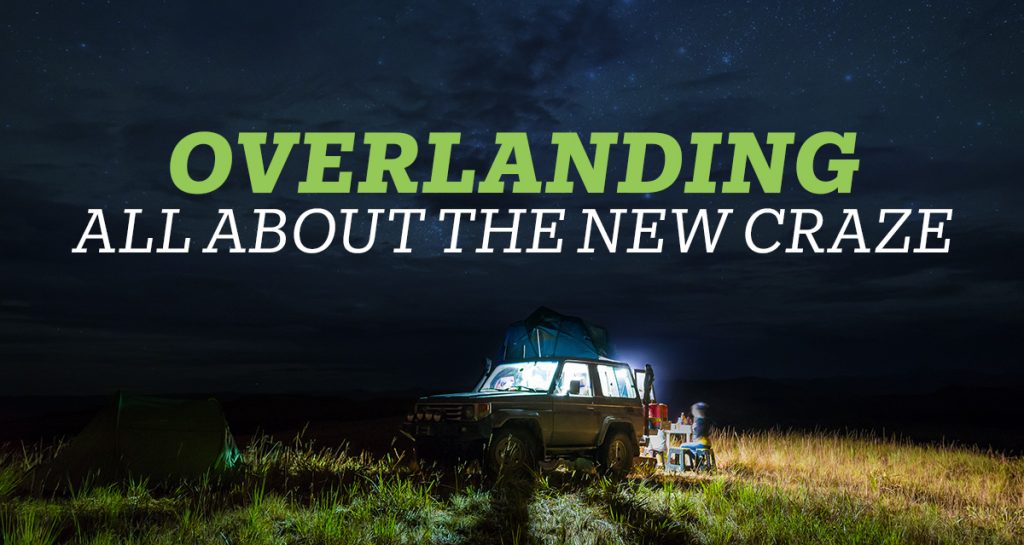If you’re the adventurous type but also have a love of tricked out vehicles – you may be familiar with the new craze known as Overlanding, although new may be an overstatement. While the – going off the grid to explore the unexplored– may be experiencing a surge in popularity,it’s not new. Exploration has been a part of the human race since, well, there were humans. Overlandjournal.com describes overlanding as “self-reliant adventure travel to destinations where the journey is the primary goal.”
What is OverLanding?
The early days of Overlanding happened on horseback, elephant, and even camel, evolving from four legs to railways, to today’s mechanized mode of four wheels or more. And it’s just such mechanization that has inspired a new generation to boldly go on adventures that are more about the getting there and how you get there than arriving. Overlanding is also about self-reliance and connecting with nature in off-road terrain or geographical areas you might not navigate on an ordinary family camping trip.
Overlanding Vehicle Must-Haves
According to a lot of off the grid fanatics, an Overlanding vehicle should include a minimum of the following characteristics:
- Reliability – no turbo-charged high HP required here. Just an engine that has easy to find parts when necessary and can run for long periods without issues.
- MPG- Fuel efficiency is going to be a essential if your next Overlanding journey is to the other side of the country.
- Durable, long-lasting off-road tires – this one is a no-brainer. After all, your tires are going to be the most used part of your vehicle on your journey. Make sure you have a portable air compressor and a tire patch kit to go along with it.
- Premium suspension – Many people upgrade the suspension to support cargo and heavier loads, but also to keep the journey a smoother ride in rugged terrain.
- Roof racks – Whether you’re driving an SUV or pulling a camper behind you, having extra storage on the top of your vehicle is pretty helpful.
Optional and Non-Optional Gear
There are virtually unlimited options for Overlanding gear, from sophisticated satellite GPS units to portable shower systems and generators.
- First Aid Kit – This falls under non-optional gear. You may never need it, but not having a reliable first aid kid is a risk you don’t want to take.
- Tools – Another must-have is a toolset with the basics for making minor vehicle repairs and even some renovations to your camping setup/equipment. But an axe, shovel, and a Jerry can for water are also pretty much non-optional.
- Food preparation & Storage – You must eat. Being able to store and prepare food efficiently is a big part of the Overlanding experience. Camp stoves and portable refrigerators that run off of your vehicle’s power can make life off the grid a whole lot easier.
- Tents, portable mattresses, sleeping bags, battery-powered fans, and auxiliary lights – depending on your personal preferences and tolerance, can be optional or essential.
Building Your Own Overland Rig
Many fans of Overlanding prefer a four-wheel-drive truck, SUV, or cargo vans that can pull off those off-road adventures, even in the roughest terrain. But the part of Overlanding that lures motorheads, gearheads and mechanically inclined fans all things automotive, to the fold? The ability to create an Overlanding rig that has the bells and whistles you decide are important. And it doesn’t have to start with a brand-new vehicle with an over the top cost.
“Outside” magazine contributor, Ty Brookhart shared his build story that began with a 1987 Toyota 4Runner with 167K miles purchased for $3200. Right out of the gate, Brookhart replaced the radiator, water pump, alternator, belts, and battery for around $500. With that many miles on the 4Runner, the initial $500 investment was well worth it.
Wheels and tires were next, and the 4Runner ended up with 16” wheels bought for $200 on Craigslist. Cooper Discoverer STT Pro tires were a little steeper at $1,100, but again – money well spent. Especially, considering what those tires have to withstand. Brookhart added 1.5” wheel spacers to add tension to the torsion bars and upgraded the suspension for a more full, more stable ride. After installing a new differential, new front and rear steel bumpers and a 10,000-pound capacity winch & cable – a star, or more accurately, a beastie Overlanding rig, was born. And for under $10K. Not too shabby.
An Overlanding adventure without mechanical skills might be tough. So, if your thirst for adventure matches a knack for understanding what makes engines tick – you’ll probably love the off-road lifestyle of Overlanding. And if putting your mechanical skills to work for you sounds like a great way to earn a living, check out the automotive and diesel technology programs at J-Tech Institute. J-Tech can help you get the training and skills you need to turn your love of automotive technology into a career. Contact us today to learn more about driving your future forward in the exciting world automotive and diesel technology.
https://www.outsideonline.com/2051956/how-build-ultimate-overland-adventure-vehicle-less-10000
